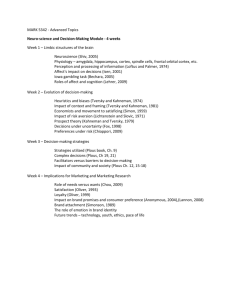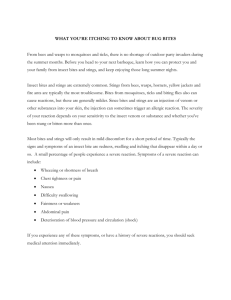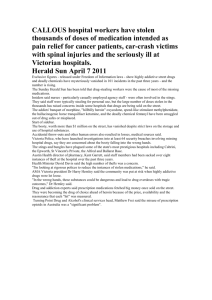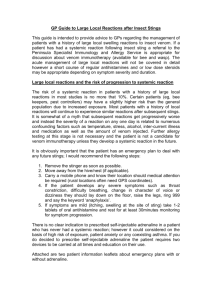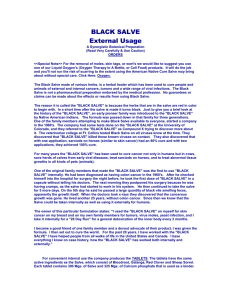Experimental Confirmation of Hypotheses Regarding the Value
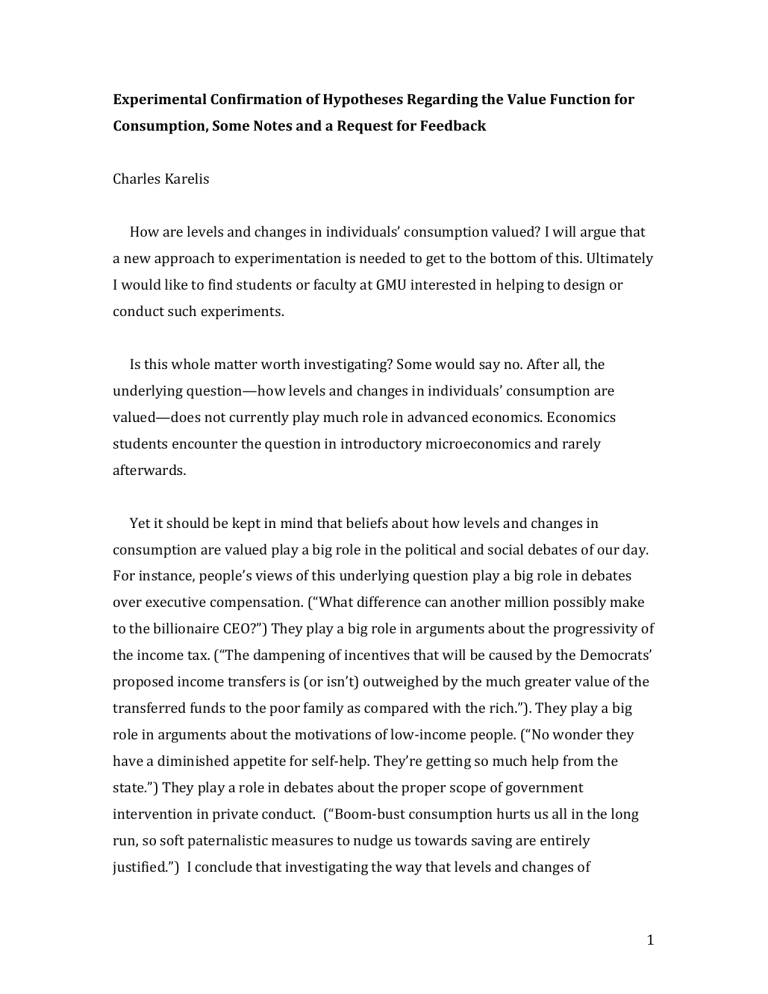
Experimental Confirmation of Hypotheses Regarding the Value Function for
Consumption, Some Notes and a Request for Feedback
Charles Karelis
How are levels and changes in individuals’ consumption valued? I will argue that a new approach to experimentation is needed to get to the bottom of this. Ultimately
I would like to find students or faculty at GMU interested in helping to design or conduct such experiments.
Is this whole matter worth investigating? Some would say no. After all, the underlying question—how levels and changes in individuals’ consumption are valued—does not currently play much role in advanced economics. Economics students encounter the question in introductory microeconomics and rarely afterwards.
Yet it should be kept in mind that beliefs about how levels and changes in consumption are valued play a big role in the political and social debates of our day.
For instance, people’s views of this underlying question play a big role in debates over executive compensation. (“What difference can another million possibly make to the billionaire CEO?”) They play a big role in arguments about the progressivity of the income tax. (“The dampening of incentives that will be caused by the Democrats’ proposed income transfers is (or isn’t) outweighed by the much greater value of the transferred funds to the poor family as compared with the rich.”). They play a big role in arguments about the motivations of low-income people. (“No wonder they have a diminished appetite for self-help. They’re getting so much help from the state.”) They play a role in debates about the proper scope of government intervention in private conduct. (“Boom-bust consumption hurts us all in the long run, so soft paternalistic measures to nudge us towards saving are entirely justified.”) I conclude that investigating the way that levels and changes of
1
consumption are valued, and the way experimentation should be used to compare competing answers, are eminently worth investigating.
In this presentation I am going to focus on one kind of answer: that in general people act so as to get as much of what they care about as possible. In other words, my starting point, which I don’t have space here to defend, is that behavioral economics underestimates the proportion of economic choice that can be rationalized. For the present, then, my question is limited to, what is the best way to rationalize economic behavior?
I will consider four approaches. (a) The marginalist theory associated with
Gosssens, Jevons, Edgeworth, and Marshall, and generally taught in introductory microeconomics courses. (b) The hypothesis centered on the inflected utility function proposed by Friedman and Savage in their 1948 Journal of Political
Economy article, “A Utility Analysis of Choices Involving Risk.” (c) The Prospect
Theory of Kahneman and Tversky, propounded in many, many articles by them and recently summarized for general readers in Kahneman’s best-selling 2011 book,
Thinking Fast and Slow. (Note that Prospect Theory understands the value being maximized by economic decisions in terms of economic losses and gains, rather than levels of wealth, but with that qualification, Prospect Theory should still be seen as a way of rationalizing economic decisions.) (d) My own view, put forward in
The Persistence of Poverty (Yale, 2007).
My own theory, which I will explain in a moment, could maybe be described as a refinement rather than an alternative to the hypothesis put forward by Friedman and Savage. But the differences are important.
First, while Friedman and Savage offer their inflected utility function as a way to rationalize common human choices involving risk, I offer my inflected utility function as a way to rationalize common choices involving not only risk but also work and consumption smoothing.
2
Second, Friedman and Savage do not pin the inflection point(s) in their hypothesized function to any particular level of consumption, whereas I hypothesize that the utility function for a given individual is inflected at the level where that individual’s consumption is no longer relieving the troubles caused by deprivation and instead begins to generate positive satisfaction.
Third, while this not strictly part of the hypothesis, I offer a “story” involving common subjective experience that I think makes hypothesizing a utility function inflected at an individual’s “poverty line” plausible.
Fourth my hypothesized function has one inflection point, while theirs has two.
In the interests of getting to the point quickly, let me present the four rationalizing hypotheses, (a) through (d), in graphic form. Kahneman’s book says that if Prospect Theory had a flag, the graphic given just below would be drawn on that flag (282). The same can be said for marginalism, the theory of Friedman and
Savage, and my own hypothesis. Here are the four flags.
.
.
.
Since my own theory is the only one that will be unfamiliar, let me try to make it seem plausible with a reminder or two of everyday experience. These reminders resemble the ones that are used in every introductory economics textbook to support the law of diminishing marginal utility. I am under no illusion that these reminders of everyday experience constitute empirical confirmation of my hypothesis, of course. On the contrary, I offer them only in hopes of showing that the hypothesis is plausible enough on the surface to deserve a rigorous experimental
3
test. (Appended to these notes, for anyone who wants more, are a chapter from my book and two quick summaries of the book, one by Tyler Cowen and the other by the author of the Rortybomb blog.)
Much or most consumption of buyable goods is consumption of what I call reliever-pleasers. These are goods which can be consumed in less-than-sufficient, sufficient, or above-sufficient amounts. When not enough is consumed, the deficiency brings troubles or miseries of various kinds, and as the deficits are made up, these troubles or miseries are more and more relieved, until there is no deficit at all. Then, as consumption continues to rise above the just-sufficient level, further consumption produces more and more positive satisfaction.
Examples of reliever-pleasers discussed in my book are transportation, leisure, living space, and opportunities to participate in community life. Consider transportation. If you don’t have a ride to and from work, and work is a long way from home, troubles ensue. For instance, you may get blisters from walking, leave dishes unwashed in the sink, and get scolded for mistakes you make on the job because you’re so tired. As you get more and more bus-fare to shorten your walk, those same troubles diminish till they vanish. On the other side of complete relief, there is luxurious transportation. If you have a ride all the way to work in a fancy car, you are likely to take positive pleasure, and the fancier the car, probably the more pleasure.
For experimental purposes, it may be easier to turn away from reliever-pleasers to the simpler cases of goods with the inherent power only to do one or the other— to relieve or please. Examples of pure pleasers would be salve for bee-stings and water to relieve thirst. Examples of pure pleasers are harder to find, because almost anything can be used to relieve some misery, but in their usual roles, at least, desserts and roller-coaster rides are pure pleasers. That said, we must recall that universally-valued goods are typically hybrid, reliever-pleasers, which relieve or please depending on our level of consumption of them.
4
My core thesis, and my main challenge to conventional marginalism, is that relievers (and reliever-pleasers at low, relieving levels of consumption) are goods that
have increasing marginal value. Imagine for instance that you’ve been stung by a bee on your hand, and that I offer to sell you a single dab of salve that will eliminate the pain of that sting. You’ll pay x dollars for the dab of salve—or exchange y hours of effort for it. But now suppose that just before you get stung on the hand, you sustain seven stings elsewhere on your body. Everyone will agree that (leaving aside special considerations like shock) the extra stings lower x, the amount you’ll pay for the dab for the sting on your hand. After all, in the case where you have those other seven stings, relieving this one sting is like quieting a single shout in a riot. Relieving that sting on your hand when there are seven others will make less perceptible difference than doing so would have made had that sting on your hand been the only one you were suffering.
Next, suppose you have sustained all eight stings, and I simply give you seven dabs of salve for the stings on your body; and then I try to sell you the dab for the still-uncured sting on your hand. Won’t the gift of the seven dabs raise (not lower) what you’ll pay for the dab for your hand? After all, because of the gift, relieving this last sting will be like quieting a shout in an otherwise quiet street. If you agree the gift of salve raises what you’ll pay for the eighth dab of salve, you are part way to agreeing that the marginal value of successive dabs of salve is increasing, not diminishing.
The behavioral corollaries of this also seem to be confirmed by common observation. For instance, most people seem to agree that if they had eight stings, they would prefer a 50/50 chance of receiving 8 dabs or zero dabs to receiving 4 dabs for sure. After all, 4 uncured stings hurt almost as much as 8, while having no uncured stings is much, much better than having 4. Likewise, when it comes to consumption smoothing, imagine you wake up each day with two stings that will hurt until night if not treated with salve, and you also get one dab of salve each
5
morning. Would you save the salve and consume it in a 2-0-2-0 pattern or would you consume it in a 1-1-1-1 pattern? From my observation, most people say the first pattern of consumption would yield great value (in this case, pain relief) in the long run. This is subject to experimental confirmation of course.
These putative facts contrast with what we know about pleaser goods like portions of dessert after dinner (and reliever-pleasers at high levels of consumption). A gift of one portion of dessert on a given night will reduce not raise what you will probably pay for a (another) portion of dessert that night. In addition, you would probably prefer a single portion for sure to a 50/50 chance of two or none. In addition, if you receive one portion a day, you will probably consume them in a 1-1-1-1 pattern, not a 2-0-2-0 pattern over time.
Weakness of empirical support for (a), marginalism
Observation (rather than formal experimentation) offers partial support but also partial disconfirmation to traditional marginalism. People buy insurance, as traditional marginalism would lead us to expect, but people also gamble at unfair odds. Traditional marginalism accommodated such recalcitrant observations by postulating that people are being irrational when they gamble, a defensive strategy tellingly criticized tellingly by Friedman and Savage for ad hoc-ism. “It is a testimony to the strength of the belief in diminishing marginal utility that it has taken so long for the possibility of interpreting gambling and similar phenomena as a contradiction of universal diminishing marginal utility, rather than of utility maximization, to be recognized.” (Stigler and Boulding anthology, 62)
Besides dismissing counterexamples as evidence of irrationality, defenders of traditional marginalism ignored an enormous volume of counterexamples entirely.
Instead they generalized from familiar cases of risk aversion and consumption smoothing that involved reliever-pleasers at pleasing levels of consumption. In other words, they didn’t even ask whether people tended to be risk averse, and to
6
smooth consumption, when dealing with reliever-pleasers at relieving levels of consumption. The reason they didn’t even ask is that they didn’t recognize a distinction between relieving and pleasing in the first place. These two very different things had been lumped together by Bentham and Mill in the idea of
“increasing utility.”
Weakness of empirical support for (b), the hypothesis of Friedman and Savage
Friedman and Savage’s failure to win broad support for their hypothesis may stem partly from the fact that they themselves offered it only as the best explanation of decisions involving risk; whereas their theory’s main rival at the time, marginalism, purported also to rationalize work effort at various income levels and intertemporal allocation of expenditures. In short, they weren’t as ambitious for their theory as the marginalists had been for theirs. In addition, due to a contextual shift towards positivistic and behavioral demonstrations in the postwar period,
Friedman and Savage didn’t avail themselves of introspective evidence for increasing marginal utility, despite the fact that the rival theory had originally been accepted on precisely that basis. Third, because their hypothesis didn’t tie inflection points to income levels, there was nothing of that kind for evidence to prove or disprove. It is difficult to provide empirical support for claims that are inherently vague.
Weakness of empirical support for (c), Prospect Theory
Kahneman and Tversky contend that the bearer of value for individuals is not absolute levels of consumption but positive or negative changes from a reference point that is normally (though not necessarily) identical to the status quo. They further contend that decision-makers are risk-averse over gains that will take them above the reference point and risk-loving over losses that will take them below the reference point. As is well-known, Kahneman and Tversky offer copious experimental evidence to support these claims.
7
Nevertheless, I suspect (and would like to show) that experiments which more closely reflected real-world economic choices than Kahneman and Tversky’s experiments do would confirm my theory rather than theirs. Let me try to make this plausible with an example.
Kahneman describes the following thought experiment in his new book. (280) We are to imagine that we’ve just been given $1000. Then we are asked to choose between (i) getting $500 more for sure and (ii) being given a .5 chance of getting another $1000 and a .5 chance of getting nothing further. The actuarial values of (i) and (ii) are the same, but Kahneman says that if we are like most people, we prefer
(i). Most people are risk averse in this choice situation.
Then he describes a second thought experiment. This time we are supposed to imagine that we have just been given $2000. Then we are asked to choose between
(iii) losing $500 for sure and (iv) being given a .5 chance of losing $1000 plus a .5 chance of losing nothing. Again, actuarial equivalency. But here Kahneman reports that if we are like most people, we will choose (iv). Most people are risk loving in this choice situation.
But of course, Kahneman points out, the two thought experiments differ only in that in one the risk being contemplated is a risk of gain, while in the other, the risk being contemplated is a risk of loss. The absolute sums involved are the same: everyone is choosing between ending up with $1500 for sure or the equal possibilities of $1000 or $2000. So, Kahneman concludes, the bearers of value and the determinants of risk aversion or risk loving for the experimental subjects must be gains and losses, not absolute levels of wealth.
Yet I suspect that the “reference-point relativity” that Kahneman and Tversky found to determine whether risk or certainty is preferred in these two thought experiments is artificial. That is, I suspect the finding of the importance of reference-
8
point relativity stems from the fact that the choices were presented to the subjects in a manner that did not invite them to imagine what the various outcomes would mean to them in real life. The numbers were presented without context, in other words. In a real world situation, for a real individual, the goods that are purchased with $1000 or any other non-trivial sum have a notable inherent capacity to bring relief or positive pleasure, quite apart from whether they are being gained or lost; and this inherent capacity will play a big role, perhaps the biggest role, in the individual’s attraction to or aversion to risk.
For example, suppose what is being bought is salve. Also suppose the price of dabs of salve is $250 each. Finally, suppose that you have eight uncured bee-stings.
Sticking with the structure of Kahneman’s “gain” thought experiment, where subjects were risk-averse, suppose you start by getting $1000, and that this enables you to relieve 4 of the stings. Next you are offered a choice. You can opt to receive another $500 for sure—which relieves 2 more and leaves 2 uncured; or you can opt to get a 50% chance at another $1000, which could bring you to complete relief of all eight stings.
Now that we know the money is going towards relievers, I bet that not only I but most people would be risk-loving, not risk-averse. I would take the bet because winning the bet and getting dabs 7 and 8 is so valuable, while losing the bet and ending up with four uncured stings instead of two uncured stings isn’t a big loss relatively speaking. This is testable, but I have a high degree of confidence that most people would reason the same way. In short, I think people will be risk-loving, not risk-averse over gains in this kind of case, so that Prospect Theory is incorrect.
In saying this I don’t mean to deny that the inherent capacity of goods in particular contexts to please or relieve distress has to be set alongside the fact that if
I gain any goods or the money to buy them I may be pleased by that gaining itself, while if I lose any goods I may be disappointed by that losing. In other words, I don’t deny that both the inherent hedonic impact of goods and the impact of gains and
9
losses are factors in decision making. Rather what I am saying is that the pleasure of the gaining and the pain of the losing will automatically appear to dominate in people’s decision making whenever we strip out or subtract, by our presentation of choices, the inherent capacity of the funds or the goods to please or relieve. And this is what seems to have happened in Kahneman’s example, due to its abstractness.
The same problem would afflict experiments in which the items gained and lost are inherently trivial to the subjects, such as pens or coffee cups; only the gaining or losing would then remain to affect choice.
It follows that if experiments designed to reveal people’s attitudes towards risk
(or work, or consumption-smoothing) are going to mirror real-world economic decision-making, the goods in question, or the quantities of the goods in question, need to be inherently and notably relieving or positively pleasing. Moreover if the experiments are going to be thought experiments, the alternatives need to be presented vividly rather than abstractly, so that subjects imagine whether the goods in question would be functioning for them as relievers or pleasers.
That condition on experiments having been met, it would be extremely illuminating to learn whether subjects were generally risk-averse over the prospect of gains in reliever goods perceived as such. Further it would illuminating to learn whether subjects were risk-averse over the prospect of losses in pleaser goods perceived as such. If those two things turned out to be the case, that would tend to support my hypothesis. On the other hand, subjects’ being risk-loving over losses in positive pleasers or their being risk-averse over gains in relievers would tend to support Prospect Theory. Subjects’ being risk-averse over gains in pleasers or riskloving over losses in relievers would not be illuminating, however, since both
Prospect Theory and my hypothesis predict that. Finally, one can imagine result that would call for a so-far uninvented hybrid of the two theories, such as subject’s being risk-loving over gains in powerful relievers but risk-averse over gains in mild relievers.
10
Accompanying these notes please find an undergraduate paper from a behavioral economics class at Williams College taught by Robert Gazzale, in which the authors,
Atkins and Romero, record and discuss an experiment aimed at confirming my hypothesis.
11

